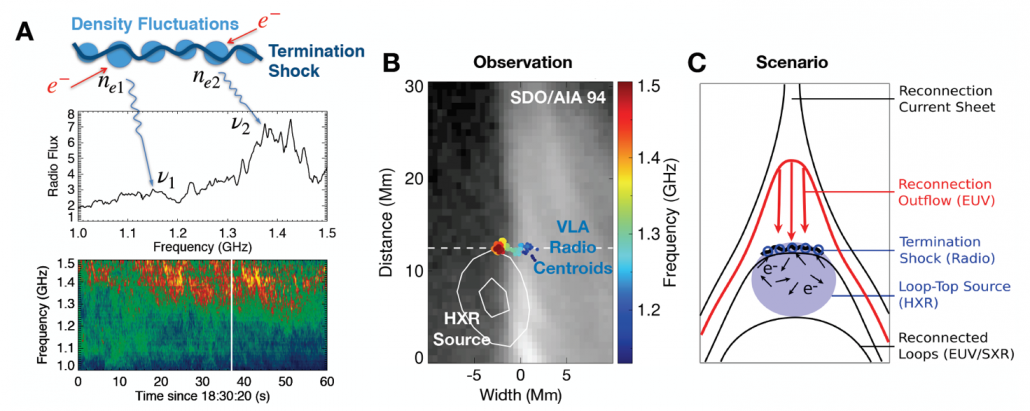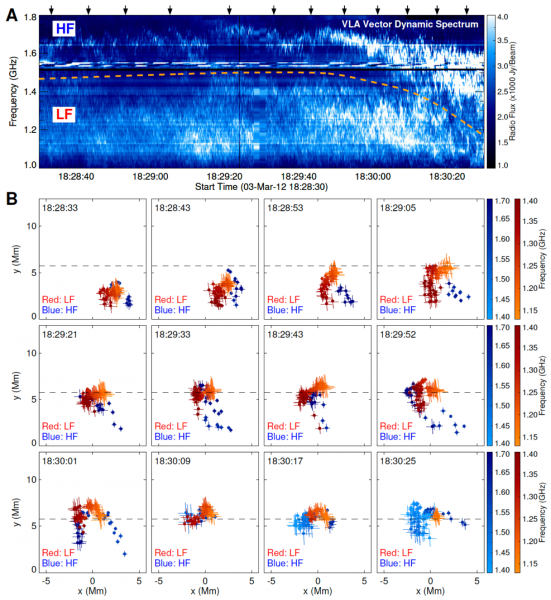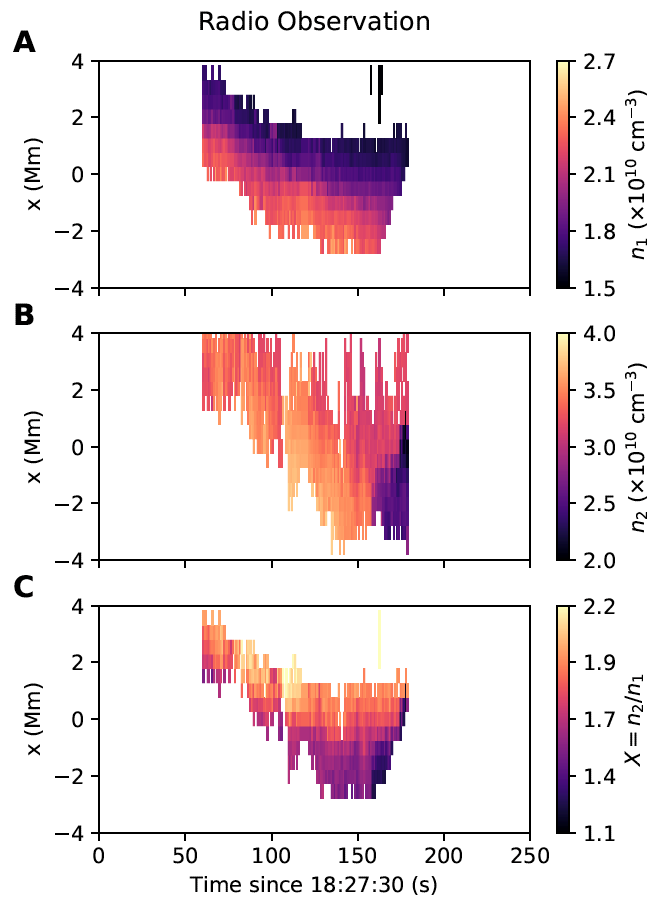In many space and astrophysical plasma contexts, shocks are considered as one of the most important mechanisms for accelerating charged particles up to relativistic speeds. Different types of shocks are present on the Sun. One of the most well-known types is shocks driven by coronal mass ejections (see, e.g., Morosan et al. 2019, and recent CESRA Nuggets by Mancuso et al., Chrysaphi et al., Zucca et al.). There is another type of shocks in solar flares driven by reconnection outflows, known as “termination shocks”. Such shocks have been proposed within the framework of the standard solar flare model as a potential particle accelerator. They have also been depicted in some of the most well-known schematics of the standard flare model (e.g., Shibata et al. 1995).
A fast-mode shock can form at the top of flare arcades if the speed of reconnection outflows impinging upon the arcades exceeds the local fast-mode magnetosonic speed (Forbes 1986). Such shocks are capable of accelerating electrons to nonthermal energies (e.g., Tsuneta & Naito 1998; Guo et al. 2012) and can produce observable radio emission (e.g., Aurass et al. 2002). Previously, in Chen et al. 2015, we used observations from the Karl G. Jansky Very Large Array (VLA) at 1–2 GHz to image a type of radio bursts likely associated with a termination shock—called “stochastic spike bursts”—with simultaneous high temporal and spectral resolution. The radio centroids outline a dynamic shock surface, located at the ending point of fast plasma downflows and above a hard X-ray looptop source (Fig. 1).

Figure 1: Schematic of the flare termination shock and the associated radio emission, which manifests as stochastic spike bursts in (A). The shock front outlined by the radio source centroids is shown as color dots in B. (Adapted from Chen et al. 2015.)
Resolving the Split-band Feature of a Flare Termination Shock
In this work, we study the so-called “split-band” feature associated with the same termination shock event reported in Chen et al. 2015: in the spatially-resolved radio dynamic spectrum, they show as two closely spaced lanes with slightly different frequencies (Fig. 2A). Such features have been previously observed in type II radio bursts associated with CME-driven shocks (e.g., Chrysaphi et al. 2018). Among others, one of the most popular interpretations attributes the higher frequency lane to the shock downstream region with a higher density, and the lower frequency lane to the shock upstream region with a lower density—because the radio emission frequency is proportional to square root of density for plasma radiation. In this scenario, the observed frequency ratio of the two lanes can be used to deduce the density compression ratio across the shock. However, in order to confirm this physical scenario and to probe the shock compression in detail, observations capable of simultaneously resolving both split-band features are required.
Thanks to VLA’s dynamic spectroscopic imaging capability, we can now image the split-band feature at both the upstream and downstream side of the termination shock simultaneously, with ~1” centroid accuracy and 50 millisecond time resolution. Fig. 2B shows the location of the split-band source centroids from the lower-frequency (red; presumably from the shock upstream) and higher-frequency (blue; downstream) lanes, respectively. They are mostly co-spatial with each other, indicating that they are likely associated with the same shock front viewed nearly edge on. Interestingly, statistically, the high-frequency source is located at a slightly lower height than the low-frequency source (by ~0.8 Mm, see Fig. 5 in the paper). This observation conforms very well with the shock upstream–downstream scenario: the high-frequency source with a higher density is located at the downstream side of the shock (toward the flare arcades), just below the low-frequency source with a lower density at the upstream side (toward the outflows). Similar to type-II-burst-emitting coronal shocks, the average density compression ratio of the shock is found to be around 1.8, which correspond to an average shock Mach number of around 1.6 (maximum up to ~2.0). This is generally consistent with results from earlier theoretical predictions and numerical experiments of the flare termination shocks in, e.g., Forbes (1986) and Shen et al. (2018).

Figure 2: (A) Split-band feature in the VLA spatially-resolved radio dynamic spectrum. HF and LF denote the high- and low-frequency split-band lane, respectively. (B) Spatial location of the frequency-dependent radio source centroids. The HF and LF sources are shown in blue and red color, respectively. Error bars show the uncertainty.
Variations of shock compression along the shock front
Moreover, with these observations, for the first time, we are able to derive the spatial and temporal variations of the density compression ratio along the shock front, shown in Fig. 3. Interestingly, one side (+x in Fig. 3C) of the shock has a stronger compression than the other side. By comparing with magnetohydrodynamics (MHD) simulations, we suggest that the observed asymmetry in shock compression may be related to the dynamic shock being disrupted by fast plasmoids. Such interactions alter the shock geometry and change the effective fast-mode Mach number along the shock front. These plasmoids are observed in EUV difference images (Fig. 9 in the paper) and predicted in the MHD simulations (Fig. 7 in the paper).

Figure 3: Observations of the density variation along the shock front and its evolution at the upstream and downstream side of the shock (panels A and B, respectively). The deduced density compression ratio across the shock is shown in (C). Horizontal axis is time. Vertical axis is along the direction of the shock front.
Conclusion
We report a detailed study of a split-band feature associated with a solar flare termination shock, by using dynamic spectroscopic imaging observations obtained by the VLA at decimetric wavelengths (1–2 GHz). The split-band feature likely corresponds to radio emission from both the upstream and downstream sides of the shock. The derived density compression ratio shows an interesting asymmetry along the shock front, which may be caused by fast plasmoids that disrupt the shock front.
Based on the recent paper by Chen, B., Shen, C., Reeves, K., Guo, F. & Yu, S. “Radio Spectroscopic Imaging of a Solar Flare Termination Shock: Split-Band Feature as Evidence for Shock Compression”, 2019, ApJ, 884, 63. DOI: https://doi.org/10.3847/1538-4357/ab3c58 Preprint: https://arxiv.org/abs/1908.09146
References
Aurass, H., Vršnak, B., Mann G. 2002, A&A, 384, 273
Chen, B., Bastian, T. S., Shen, C., et al. 2015, Science, 350, 1238
Chrysaphi, N., Kontar, E. P., Holman, G. D., et al. 2018, ApJ, 868, 79
Forbes, T. 1986, ApJ, 305, 553
Guo, F., Giacalone, J. 2012, ApJ, 753, 28
Morosan, D. E., Carley, E. P., Hayes, L. A., et al. 2019, Nat Astron, 3, 452
Shen, C., Kong, X., Guo, F., et al. 2018, ApJ, 869, 116
Shibata, K., Masuda, S., Shimojo, M. et al. 1995, ApJ, 451, 83
Tsuneta, S., Naito, T. 1998, ApJ, 495, 67
